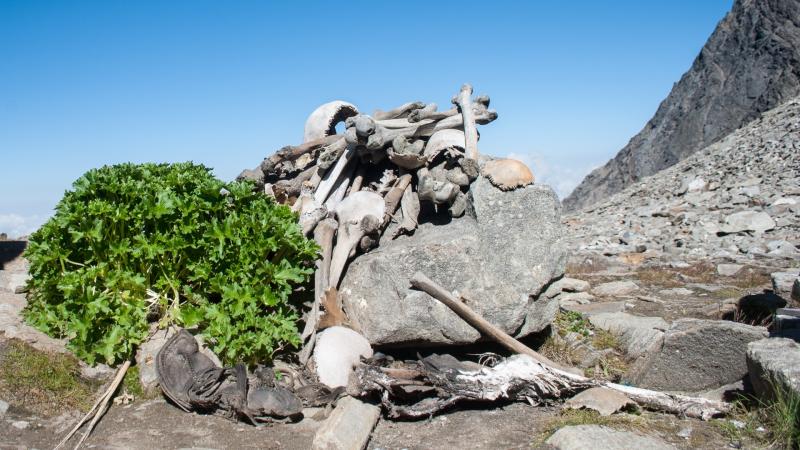
Roopkund is a small Himalayan glacial lake in Uttarakhand, situated at an altitude of about 16,470 feet. With its breathtaking scenery, it is a popular trekking destination. However, there is more to this mysterious lake—hundreds of ancient human skeletons lie scattered here, earning it the name ‘skeletons lake’. The origin of these skeletons is a mystery, with some believing that these people died during a single catastrophic event. There are alluring stories about these unfortunate people being a king and his attendants, army or group of merchants caught in a storm or victims of an epidemic. Nevertheless, none of these has any evidence.
In a recently published decade-long study, an international team of researchers seem to have traced the origins of these puzzling skeletons. The team consisted of researchers from India, the USA and Germany. Their findings have been published in the journal Nature Communications.
The researchers used ancient DNA samples isolated from 38 skeletal remains to retrieve detailed or genome-wide information, a first-of-its-kind attempt in India, to find clues about their origin. They tried to date these remains using radiocarbon dating—a method for determining the age of an object by looking for radioactive carbon isotopes in the sample. Besides, they also analysed bone proteins to know about the diets of these individuals. The study uncovered a vivid tale behind these skeletons, disproving all popular beliefs.
The findings revealed that these skeletons belong to three genetically distinct groups. The first group, consisting of 23 individuals, were of South Asian or Indian origin. The second group of 14 individuals, surprisingly, were of the eastern Mediterranean or present-day Crete (an island in Greece) and Greek origin. The third group had one individual with Southeast Asian ancestry. None of these individuals showed any genetic similarity to people from the Himalayan region, including those from northern Ladakh. The analysis of collagen, a bone protein, found that the diets of the three groups of people were different from each other, supporting the evidence that they belong to distinct groups. The study further found that the skeletons were deposited in Roopkund at various periods, disproving the widely-held ‘single catastrophic event’ theory. Individuals of Indian origin, whose skeletons were found at Roopkund, could have died here between 7th and 10th century. The remains of those from the Mediterranean and Southeast Asia reached there almost 1000 years later, between the 17th and 20th century.
The skeletal remains belong to both males and females. So, were they warriors? “The relatively similar proportion of males and females is difficult to reconcile with the suggestion that these individuals might have been part of a military expedition,” say the researchers, negating that theory. They also did not find much evidence to establish that these people belong to some groups of families. Moreover, they did not find any trace of pathogen infection to believe the theory of deaths due to an epidemic.
So, why then did so many people end up at Roopkund, a lake that is en route to the Nanda Devi Raj Jat pilgrimage? Here lies a clue that could explain the death of Indian origin individuals, say the researchers. “We view the hypothesis of mass death during a pilgrimage event as a plausible explanation for at least some of the individuals in the first group,” they suggest.
Although the same might be true for the Southeast Asian individual, finding a probable explanation for the death of the eastern Mediterranean individuals is very puzzling.
“It would be surprising for a Hindu pilgrimage to be practiced by a large group of travellers from the eastern Mediterranean, where Hindu practices have not been common,” explain the researchers.
They suggest archival research to determine if there were reports of large foreign travellers dying in the region over the last few hundred years. Learning about the past with historic and acceptable evidence is exciting but not easy. For places like Roopkund, it is a massive challenge. The lake is not easily accessible, and local pilgrims and hikers have fiddled with the skeletons and have removed many of the artefacts. However, with what little is available, this study attempts to uncover their mysteries using scientific advances in molecular biology.





